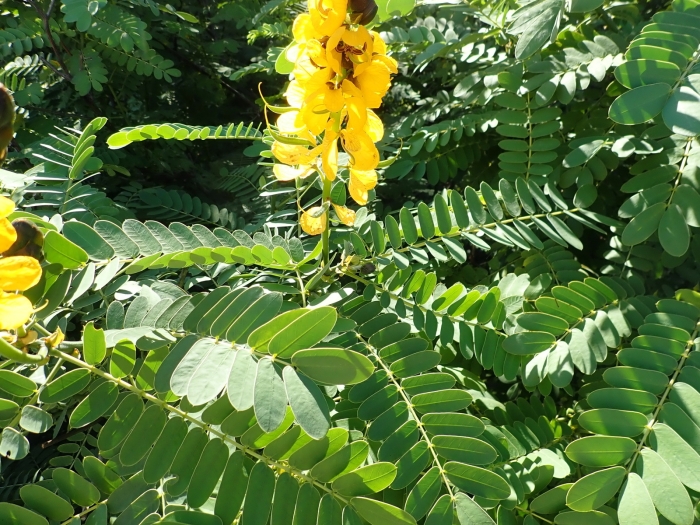African Senna
(Senna didymobotrya)
African Senna (Senna didymobotrya)
/
/

Nicola van Berkel
CC BY-SA 4.0
Image By:
Nicola van Berkel
Recorded By:
Copyright:
CC BY-SA 4.0
Copyright Notice:
Photo by: Nicola van Berkel | License Type: CC BY-SA 4.0 | License URL: http://creativecommons.org/licenses/by-sa/4.0/ | Rights Holder: Nicola van Berkel | Publisher: iNaturalist | Date Created: 2018-04-01T09:44:10-07:00 |



















































Estimated Native Range
Summary
Senna didymobotrya, commonly known as African Senna, is an evergreen shrub with a hairy and aromatic presence, native to open woodlands and grasslands of the mountainous regions of East Africa, including countries like Kenya and Uganda. It typically grows to about 5 meters tall but can reach heights of up to 9 meters in optimal conditions. The plant’s unique scent is reminiscent of various odors, including mice, wet dog, peanut butter, and burnt popcorn, which is particularly noticeable when the leaves are crushed.
African Senna’s leaves are impressive, reaching up to half a meter in length, with numerous pairs of elongated oval leaflets, each up to 6.5 centimeters long. It blooms profusely with racemes of bright yellow flowers that are quite showy, and additional flowers can be found in the leaf axils. Each flower features five concave petals, ranging from 1.5 to nearly 3 centimeters in length. After flowering, it produces a flat brown legume pod, up to 12 centimeters long, containing up to 16 bean-like seeds, each about a centimeter long. This shrub is valued for its ornamental bright yellow flowers and its ability to attract pollinators. Commonly used in tropical and subtropical gardens, it can serve as a hedge or screen and is also noted for its potential medicinal properties. African Senna thrives in full sun and requires high amounts of water, preferring soils with fast drainage. It is relatively easy to maintain but can be susceptible to pests like spider mites and aphids. Gardeners should be aware that all parts of the plant are toxic if ingested.CC BY-SA 4.0
African Senna’s leaves are impressive, reaching up to half a meter in length, with numerous pairs of elongated oval leaflets, each up to 6.5 centimeters long. It blooms profusely with racemes of bright yellow flowers that are quite showy, and additional flowers can be found in the leaf axils. Each flower features five concave petals, ranging from 1.5 to nearly 3 centimeters in length. After flowering, it produces a flat brown legume pod, up to 12 centimeters long, containing up to 16 bean-like seeds, each about a centimeter long. This shrub is valued for its ornamental bright yellow flowers and its ability to attract pollinators. Commonly used in tropical and subtropical gardens, it can serve as a hedge or screen and is also noted for its potential medicinal properties. African Senna thrives in full sun and requires high amounts of water, preferring soils with fast drainage. It is relatively easy to maintain but can be susceptible to pests like spider mites and aphids. Gardeners should be aware that all parts of the plant are toxic if ingested.CC BY-SA 4.0
Plant Description
- Plant Type: Shrub
- Height: 2-5 feet
- Width: 1-3 feet
- Growth Rate: Rapid
- Flower Color: Yellow
- Flowering Season: Spring, Summer, Fall
- Leaf Retention: Evergreen
Growth Requirements
- Sun: Full Sun
- Water: Medium
- Drainage: Fast
Common Uses
Bee Garden, Bird Garden, Butterfly Garden, Deer Resistant, Drought Tolerant, Fragrant, Showy Flowers
Natural Habitat
Open woodlands and grasslands
Other Names
Common Names: Candelabra Tree , Peanut Butter Cassia , African Senna , Popcorn Senna , Candelabra-Tree , Grondboontjiebotterkassia , Geflügelte Kassie , Kandelaberkassia
Scientific Names: Senna didymobotrya , Cassia didymobotrya , Cassia nairobensis , Cassia bracteosa , Cassia nairobiensis , Cassia verdickii , Chamaesenna didymobotrya
GBIF Accepted Name: Senna didymobotrya (Fresen.) H.S.Irwin & Barneby